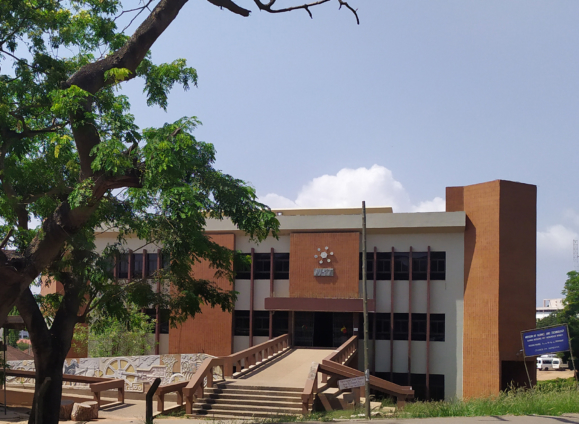The Museum of Science and Technology cannot be missed. It sits on the left side of the intersection of Barnes Road and Liberia road if you’re coming from the Trade Union Congress (TUC) building. It’s a huge brown tiled monolith with a suspended bridge walkway, and of course, bold signage telling you it’s the Science Museum.
The architecture of the building could easily pass for a 21st-century Ghanaian church building; functional, chunky, uninspiring.
The Museum is currently holding a “Back to Science” exhibition which runs throughout the week from Monday to Sunday. On Sundays, it opens only after church hours.
The Museum takes an entry fee ranging from around ¢5 for children to ¢10 for Ghanaian adults. Foreigners pay a little more.
On signage posted on the entrance wall of the Museum, it explained that the Museum’s exhibition was in four thematic areas. These were Human biology, Transportation, Communication and the Animal World.
The entire ‘Back to Science’ exhibition is assembled on just one floor of the Museum. If you were to stand in the middle of the building’s atrium and spin you could see the entire exhibition room.
My tour began at the Communication wing of the Museum. I was reintroduced to the Fontomfrom, Atumpan and Gong as an early form of communication in Ghana. We quickly moved to the display of telegraph machines, direct line phone services, the evolution of telephones and mobile phones etc.
There were also a few typewriters and calculators on display, and some TVs and radios. Among the TV sets, the most memorable one for me was the Sanyo Ghana TV. According to the tour guide, Kofi, Ghana once had a TV production deal with Japan’s Sanyo, as we do now with Volkswagen. There was a TV production plant that produced the television set already boxed in its wooden frame.
There was a large radio set too on the site, boxed in wood like the Sanyo Ghana TV which still worked. Apparently, it had been fixed by technicians from the Kwame Nkrumah University of Science and Technology (KNUST). I only hoped they had fixed the TV sets too.
In a corner, was an exhibition by a PhD student, who had repurposed spoilt computers into new artefacts, such that they were given new life sitting pretty in a Museum building. Kofi says one could play games on the repurposed computers; however, considering the ‘no touching’ rule of the Museum, I guess the games on the machines are obsolete.
Still on the Communication side of the Exhibition (it’s the thematic area with the most artefacts on display) I was shown large studio cameras and projectors from years ago. One of such cameras had been donated by NAFTI to the Museum.
From there, the next thematic area to be explored was the animal world side. There was much to be desired.
It had a collection of preserved fishes in glass jars stuck to a wall that had been covered in a picture poster showing the depths of the ocean. At a good angle, it gave the impression the fishes were swimming in the deep blue ocean background. Nice.
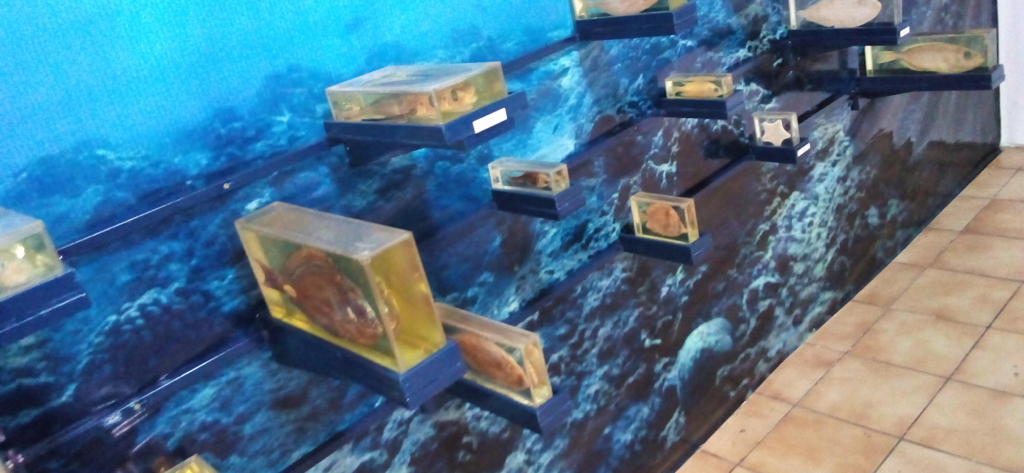
Then on display were some bones. These included the upper jaw bone of a whale, the skull of an elephant, the skull of a bush pig (probably a warthog), and horns (most definitely belonging to an antelope or someone from that family).
I wondered where the rest of the elephant and whale had gone to. Besides, this is only the second time I’m seeing the skull of an elephant. There was one on display at the Kakum National Park. There too the rest of the elephant was gone.
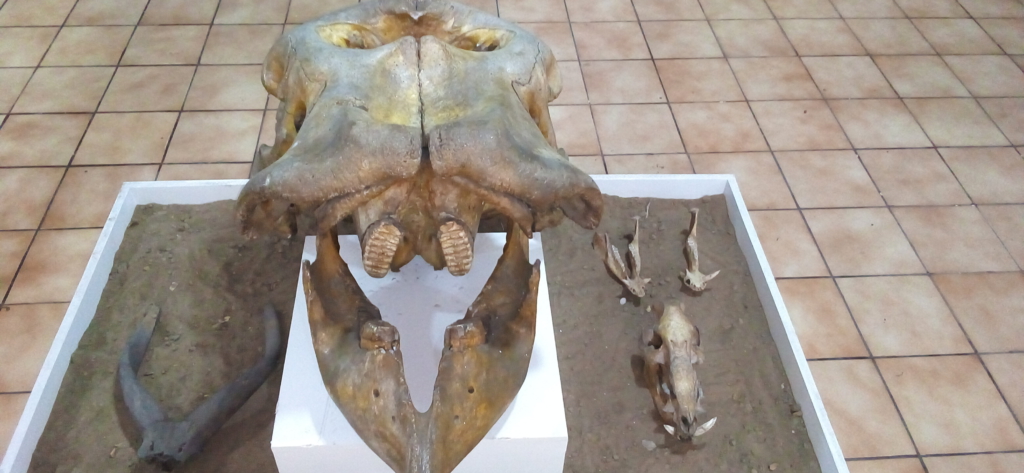
There were also the head of a water buffalo and a stuffed baby crocodile on display, preserved via taxidermy. The two were gifts from Heads of States to late Former President Rawlings, who later donated them to the Museum. And the last thing on an exhibition on the Animal side was a photo gallery of captured monkeys.
These were to spread awareness of the harm we cause monkeys when we try to domesticate or make pets of them. Lots of Ghanaian monkeys are going extinct as a result of human activities, Kofi said.
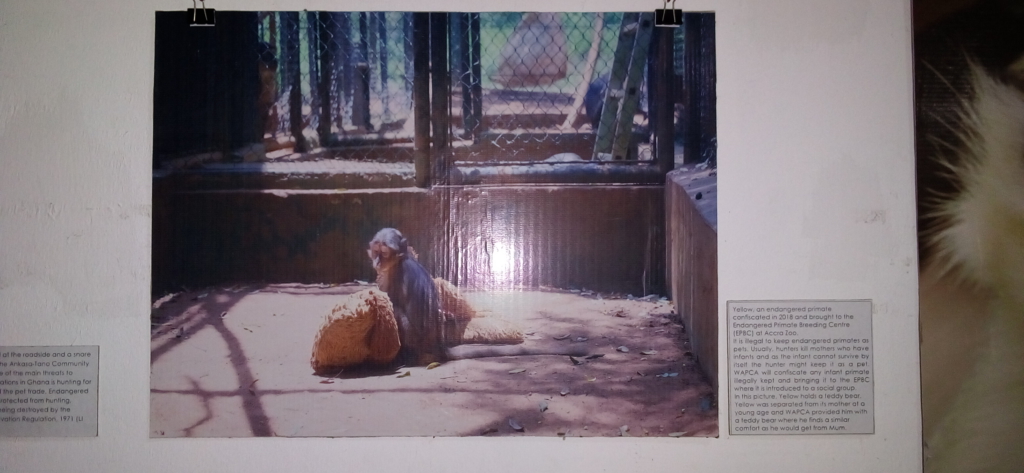
I noticed birds, amphibians, and reptiles, save the stuffed crocodile, were not on display.
We moved next to Human biology. I believe the most exciting part of the Human Biology exhibition was the display of body tissues and a miscarried foetus. They had been donated by the University of Ghana to the Museum. In clear glass jars were brain tissue, sliced open kidney, a liver, a placenta and the remains of a miscarried baby.
Staring at the miscarried baby, perfectly stored in the glass chamber was quite surreal to me.
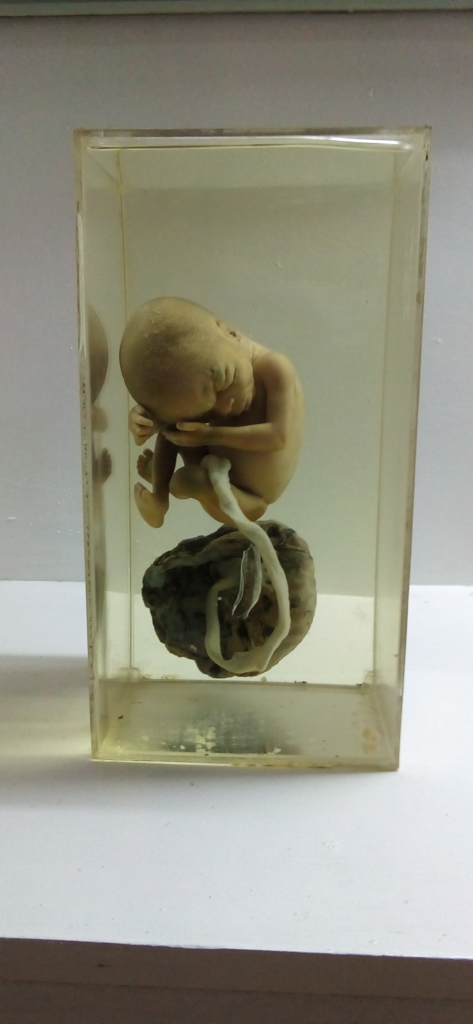
The rest on display were diagrams and a mechanised rendition of how oxygenated blood moved in your body.
An exciting thing I learned from that section was the research by a woman which showed that when the sperm meets the egg during fertilization, it causes a spark of light before the egg is fertilized.
The final thematic area to be explored was Transportation. Things on display there included a cake of raw rubber donated by the Ghana Rubber Company, a firestone tyre (apparently these were made in Ghana), a model of the Bia River Ship which formed part of the erstwhile state-owned Black Star Shipping Company, and a bamboo bicycle which had been rode across Ghana.
Also, there were a model propeller engine, a car shank, the remains of a truck, an amour car made from scraps, a motor bicycle, a wooden space shuttle, and pictures of Ghana’s once-famous boneshakers, the Boafo trucks.
And right there in the centre of the building, hanging from the roof of the atrium is a made-to-size replica of the Sputnik satellite, the first to be launched into space.
The interesting thing about that sector was finding out that Ghana once had an indietech fest, where everyday people were encouraged to come to showcase their own inventions. The armoured truck was a winning invention at one of those events.
The maker had ridden it from Kumasi Magazine to Accra to partake in the festival.
The Good
It is exciting that we have a Museum dedicated to Science in the first place. It shows we are at least making an effort in recognizing the importance of science.
I enjoyed very much the tour guide’s efforts in making the very scarce artefacts available to him very exciting and an enjoyable experience. From him, I finally understood the differences between the various generations of computers.
It also occurred to me the Museum was making an effort to get more people interested in actually making it to the Museum. Their Back to Science exhibition and the fact that the place will be opened throughout the week is commendable.
The Bad…and the gaping gap
There was much to be desired.
Taking a good look at the building you could easily tell it was poorly funded and really grabbing at straws to stay afloat.
Save the Communication themed side, much of the rest of the exhibition had quite few artefacts on display. As I mentioned earlier, except for a stuffed crocodile, there were no reptiles, neither were there birds. And if not for the pictures of the monkeys, the whale and the head of the water buffalo, neither would there be mammals on display. Amphibians too.
I wonder what this says about the country though; that there are no taxidermists willing to preserve creatures that for instance die in the zoo (is the Kumasi zoo still active?) or even from our game reserves? Or the government just doesn’t care?
And besides, is it an ask to have the entire skeletal remains of an elephant on display? What is our fascination with skulls only?
And didn’t whales wash up on our shores just recently during the sea stress phenomenon? Why didn’t we get their entire skeletal remains on display and only got an upper jaw bone? We’re not even asking for dinosaur bones, pft.
Also, the Museum was pretty small. I noted earlier that it was chunky, true, but inside it was really small. I expected it to be much bigger in order to contain more interesting objects. Imagine, there was no model of the solar system floating around in the Museum. Sad.
For a country that is trying to promote STEM education, our Museum doesn’t seem to have gotten the memo. There are just four thematic areas on display when for instance the London Science Museum has about 12 thematic areas.
These include; Robots, astronomy, art and science, computing, mathematics, space, communication, women in science, our environment, everyday technology, medicine and chemistry.
There was also an underrepresentation, or perhaps a lack of representation of Ghanaian scientists and inventions in the Museum. There was not even an image of Ave Kludze (Rocket scientist), Professor Allotey (Mathematician), Ashittey Trebbi Ollenu (Rocket scientist) and Thomas Mensah (Nanotechnician), famous Ghanaian scientists.
And if the male scientists were even underrepresented, female scientists were not even mentioned at all. If not at all, Susan Barbara Gyankroma Ofori-Atta a relative to both the sitting President, Akufo-Addo and the Finance Minister, Ken Ofori-Atta should have been represented for being the first female Medical doctor in Ghana and contributing to the research on Kwashiorkor.
Oh, and where was the moonstone? Apparently, there used to be one on display at the Museum when it opened in 1963. So what happened?
The Way Forward
To show our commitment to STEM education and Research in Ghana, I believe it is time we relocated the Museum to a new and larger location, designed to world-class architectural standards, in order to reflect our vision for the future.
I mean, a building that strikes awe in people who visit should not be too much to ask for.
The Museum should also look at expanding its thematic areas. We can always pick notes from other more established museums to guide our own expansion.
I also call on Universities in the country, especially the science universities to collaborate more with the Museum. For instance all the human tissues on display there were donated by the University of Ghana. It’s about time the other Universities pulled their weight to support the University too, with artefacts, research materials, knowledge etc.
Still, on promoting STEM education in Ghana, I believe it is prudent to re-establish the Indietech festival. It shouldn't always be the case that we discover bright minds on social media and hope that some philanthropist, after 1000 retweets, sees what the talent is capable of and decides to sponsor their education or give them a chance. The government should take the lead in this by giving people the platform to exhibit what they're capable of.
And I call on the government to release adequate funding for our Museums.
The Museum should also invest in a website of its own.
And finally, bring back the moonstone.
In conclusion, in as much as it was a bittersweet experience for me at the Museum, I would encourage more Ghanaians to visit there. There are some exciting things there to see, and there’s something new to learn. Besides they also need the money if they’re to expand.
Also, don’t forget to leave suggestions in the suggestion book at the end of your tour. I read one Alphabeta student’s suggestion asking for a space observatory deck and some other space-y stuff. LOL.
I hope we all get to see our suggestions take shape one day soon.
You can follow the author, Cornerlis Kweku Affre on Twitter @cornerlis
Latest Stories
-
Environmental protection officers receive training on how to tackle climate change
2 minutes -
CLOGSAG vows to resist partisan appointments in Civil, Local Government Service
1 hour -
Peasant Farmers Association welcomes Mahama’s move to rename Agric Ministry
1 hour -
NDC grateful to chiefs, people of Bono Region -Asiedu Nketia
1 hour -
Ban on smoking in public: FDA engages food service establishments on compliance
1 hour -
Mahama’s administration to consider opening Ghana’s Mission in Budapest
1 hour -
GEPA commits to building robust systems that empower MSMEs
1 hour -
Twifo Atti-Morkwa poultry farmers in distress due to high cost of feed
1 hour -
Central Region PURC assures residents of constant water, power supply during yuletide
1 hour -
Election victory not licence to misbehave – Police to youth
1 hour -
GPL 2024/2025: Nations thrash struggling Legon Cities
1 hour -
Electoral offences have no expiry date, accountability is inevitable – Fifi Kwetey
1 hour -
Ghanaians to enjoy reliable electricity this Christmas – ECG promises
2 hours -
Police deny reports of election-related violence in Nsawam Adoagyiri
2 hours -
‘We’re not brothers; we’ll show you where power lies’ – Dafeamekpor to Afenyo-Markin
2 hours

